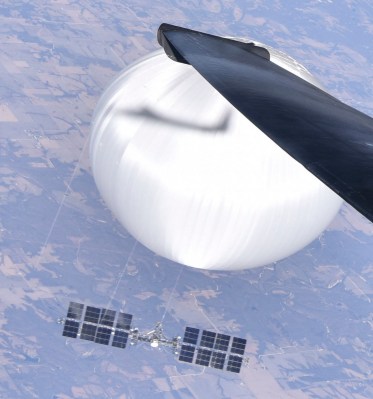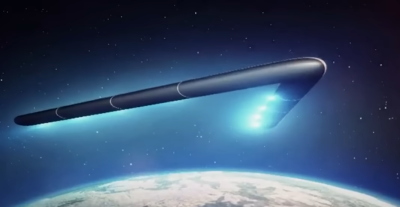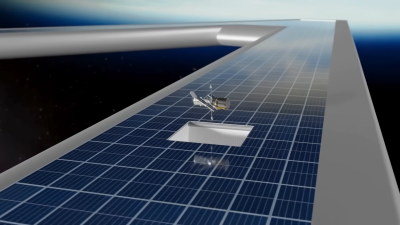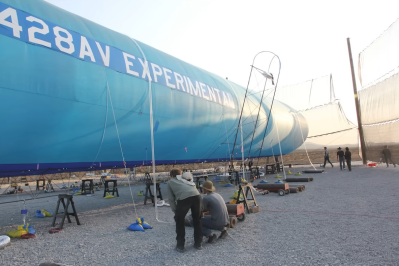There have been all kinds of wild ideas to get spacecraft into orbit. Everything from firing huge cannons to spinning craft at rapid speed has been posited, explored, or in some cases, even tested to some degree. And yet, good ol’ flaming rockets continue to dominate all, because they actually get the job done.
Rockets, fuel, and all their supporting infrastructure remain expensive, so the search for an alternative goes on. One daring idea involves using airships to loft payloads into orbit. What if you could simply float up into space?
Lighter Than Air

The concept sounds compelling from the outset. Through the use of hydrogen or helium as a lifting gas, airships and balloons manage to reach great altitudes while burning zero propellant. What if you could just keep floating higher and higher until you reached orbital space?
This is a huge deal when it comes to reaching orbit. One of the biggest problems of our current space efforts is referred to as the tyranny of the rocket equation. The more cargo you want to launch into space, the more fuel you need. But then that fuel adds more weight, which needs yet more fuel to carry its weight into orbit. To say nothing of the greater structure and supporting material to contain it all.
Carrying even a few extra kilograms of weight to space can require huge amounts of additional fuel. This is why we use staged rockets to reach orbit at present. By shedding large amounts of structural weight at the end of each rocket stage, it’s possible to move the remaining rocket farther with less fuel.
If you could get to orbit while using zero fuel, it would be a total gamechanger. It wouldn’t just be cheaper to launch satellites or other cargoes. It would also make missions to the Moon or Mars far easier. Those rockets would no longer have to carry the huge amount of fuel required to escape Earth’s surface and get to orbit. Instead, they could just carry the lower amount of fuel required to go from Earth orbit to their final destination.

Of course, it’s not that simple. Reaching orbit isn’t just about going high above the Earth. If you just go straight up above the Earth’s surface, and then stop, you’ll just fall back down. If you want to orbit, you have to go sideways really, really fast.
Thus, an airship-to-orbit launch system would have to do two things. It would have to haul a payload up high, and then get it up to the speed required for its desired orbit. That’s where it gets hard. The minimum speed to reach a stable orbit around Earth is 7.8 kilometers per second (28,000 km/h or 17,500 mph). Thus, even if you’ve floated up very, very high, you still need a huge rocket or some kind of very efficient ion thruster to push your payload up to that speed. And you still need fuel to generate that massive delta-V (change in velocity).
For this reason, airships aren’t the perfect hack to reaching orbit that you might think. They’re good for floating about, and you can even go very, very high. But if you want to circle the Earth again and again and again, you better bring a bucketload of fuel with you.
Someone’s Working On It

Nevertheless, this concept is being actively worked on, but not by the usual suspects. Don’t look at NASA, JAXA, SpaceX, ESA, or even Roscosmos. Instead, it’s the work of the DIY volunteer space program known as JP Aerospace.
The organization has grand dreams of launching airships into space. Its concept isn’t as simple as just getting into a big balloon and floating up into orbit, though. Instead, it envisions a three-stage system.
The first stage would involve an airship designed to travel from ground level up to 140,000 feet. The company proposes a V-shaped design with an airfoil profile to generate additional lift as it moves through the atmosphere. Propulsion would be via propellers that are specifically designed to operate in the near-vacuum at those altitudes.
Once at that height, the first stage craft would dock with a permanently floating structure called Dark Sky Station. It would serve as a docking station where cargo could be transferred from the first stage craft to the Orbital Ascender, which is the craft designed to carry the payload into orbit.

The Orbital Ascender itself sounds like a fantastical thing on paper. The team’s current concept is for a V-shaped craft with a fabric outer shell which contains many individual plastic cells full of lifting gas. That in itself isn’t so wild, but the proposed size is. It’s slated to measure 1,828 meters on each side of the V — well over a mile long — with an internal volume of over 11 million cubic meters. Thin film solar panels on the craft’s surface are intended to generate 90 MW of power, while a plasma generator on the leading edge is intended to help cut drag. The latter is critical, as the craft will need to reach hypersonic speeds in the ultra-thin atmosphere to get its payload up to orbital speeds. To propel the craft up to orbital velocity, the team has been running test firings on its own designs for plasma thrusters.

The team at JP Aerospace is passionate, but currently lacks the means to execute their plans at full scale. Right now, the team has some experimental low-altitude research craft that are a few hundred feet long. Presently, Dark Sky Station and the Orbital Ascender remain far off dreams.
Realistically, the team hasn’t found a shortcut to orbit just yet. Building a working version of the Orbital Ascender would require lofting huge amounts of material to high altitude where it would have to be constructed. Such a craft would be torn to shreds by a simple breeze in the lower atmosphere. A lighter-than-air craft that could operate at such high altitudes and speeds might not even be practical with modern materials, even if the atmosphere is vanishingly thin above 140,000 feet. There are huge questions around what materials the team would use, and whether the theoretical concepts for plasma drag reduction could be made to work on the monumentally huge craft.

Even if the craft’s basic design could work, there are questions around the practicalities of crewing and maintaining a permanent floating airship station at high altitude. Let alone how payloads would be transferred from one giant balloon craft to another. These issues might be solvable with billions of dollars. Maybe. JP Aerospace is having a go on a budget several orders of magnitude more shoestring than that.
One might imagine a simpler idea could be worth trying first. Lofting conventional rockets to 100,000 feet with balloons would be easier and still cut fuel requirements to some degree. But ultimately, the key challenge of orbit remains. You still need to find a way to get your payload up to a speed of at least 8 kilometers per second, regardless of how high you can get it in the air. That would still require a huge rocket, and a suitably huge balloon to lift it!
For now, orbit remains devastatingly hard to reach, whether you want to go by rocket, airship, or nuclear-powered paddle steamer. Don’t expect to float to the Moon by airship anytime soon, even if it sounds like a good idea.















JP aerospace’s airship to orbit is a completely ridiculous concept. Unless they can get near magical hypersonic drag reduction tech to work it’s pointless, there’s just no way they can overcome drag for the airship to reach orbit with the power available. And as far as I can tell they’ve done little to demonstrate that this tech works and at the scale of a huge airship.
Perhaps they believe the “constant thrust > speed” argument used in the 1963 movie “The Mouse on the Moon”?
https://en.wikipedia.org/wiki/The_Mouse_on_the_Moon
It’s a ‘well known fact’ that the moon is just an airship.
Once you realize the earth is flat and ‘orbit’ is just dumb, it’s obvious.
Wake up sheeple! (Don’t wake the sheeple).
You woke the sheeple.
~Rock a bye baby~ …
The Earth is flat? What scale are you thinking of? Glaciers made flat planes, but overall the Earth is a sort of sphere. It’s how gravity works – sphere’s are preferred for a uniform gravity distribution. Imagine if God hadn’t developed physics, how would he have been able to rest on the 7th day?
That’s what ‘they’ want you to believe.
You must be English. Limeys just don’t get sarcasm.
It’s still a fun problem on paper. I once worked out that if you had an airship with the same shape size and thrust of a 1930s Zeppelin but neutrally buoyant at 50 km, it would have a terminal velocity over Mach 3, because the air is so thin up there.
Airship TO orbit is madness.
Airship-From-Orbit? That’s LOFTID on steroids.
Let me explain…
If Mars is the planet where SSTOs have a chance of working-then Venus is the planet for airships.
The HAVOK manned Venus mission should be airship-from-orbit.
At Venus, the 1 atm envelope IS the gondola.
You launch Starship and inflate the craft in space.
This will be a solar power dirigible with solar electric…ion drive in space…becoming ion wind at Venus.
This is a combination airship ballute that slows down at Venus using the opposite approach Powell describes.
The guys at JP are super cool and do a lot of educational outreach. Wish someone would throw them some real money.
Fun factoid, they were the first non-edu customer for the Parallax Basic Stamp back in the 90s.
It’s a total scam. Nobody should give them any money. This “project” has been around for a quarter century, and has made zero progress.x
They’re building the stuff that they say they want to build, and document their work pretty thoroughly. An optimistic dream maybe, but not a scam.
No, they are building the stuff that has money allocated to by bean counters. They might be building orher less involved stuff if they can use left over funding
Sounds a lot like ‘never trust anyone over 30’ to me; succeed and hand it off when you cross the broom.
So, it’s a two-step process involving a high altitude floating platform, with a fanciful unobtanium plasma drive for the boost to orbital speed.
So pick something else for the second step, like an orbiting skyhook (momentum exchange tether). It’s the best of both worlds: We don’t need to invent a magical plasma drive, and the skyhook doesn’t need to deal with navigation of the hook through dense lower atmosphere at supersonic speed.
And the skyhook has the added feature of sweeping derelict (mostly) satellites out of low-Earth orbit.
Hey, the more mass it can accrete, the better it works!
Haha, space pirates, stealing satellites for mass
That soft robots with 24km/s matching repair stations thing sounds fun!
So float the first stage up to the top of the atmosphere. Design it so it floats on top of the atmosphere like a boat on water. Ion thrusters aren’t quite developed enough yet, so what about a really, really big sling shot? Then we just sink the “boat” somehow so we can reload the slingshot.
sink the boat somehow by slingshotting the payload not only sideways-real-fast but also up? Maybe launch 2 satellites at once: sideways in opposite directions, and both up a bit. So the boat does not go sideways that much.
Slingshot could be a centrifuge, railgun, rocket, or anything sufficiently power dense?
Balloon first stage followed by centrifuge sounds like a very awkward system to make work, what with the centrifuge itself being heavy and probably needing two of them counter-rotating to avoid spinning the balloon around, but if the reduced atmospheric drag from launching so high allows it to spin up faster or without further evacuation of the chamber, that could be a really fun way to move cargo.
Credit to Neal Stephenson for this idea, no?
“You’ve Probably Never Considered Taking An Airship To Orbit”
I did, I did! 😁 But to be fair, not on planet earth.
I had sci-fi day dreams of some sort of airships floating in high-altitude on other planets, like Venus.
These ships had a bit of Victorian era of flair, a bit like Disney Nautilus had.
With a bit of Titanic era furniture, maybe.
I believe I got that idea by reading about those hypothetical “jellyfish” creatures floating in upper atmosphere of gas giants.
Didn’t Carl Sagan wrote about such things, maybe?
Land and overland by Bob Shaw had a theme of two planets orbiting so close together it was one atmosphere – and some hand wavy gravity (he sort of admits it). Then the story was a group of people traveling to ‘overland’ after they had existential circumstances making Land uninhabitable.
The airships (and battles later on) were very Verne like.
– I didn’t read the 3rd book.
Wow, sounds like a good read, thank you very much for telling us/me about it. 😃👍
– I’ll see if I can get hold of a copy of the first book.
Rocheworld (Robert Forward) also featured two planets rotating in contact. Amazing ideas in his books. They made the writing worth reading.
Thanks! I love such science fiction stories. 😎
I used to read my father’s old Perry Rhodan magazines since I was little (and the spin-offs).
Just air launch from 300,000 feet.
JP
ps. we show our work: https://www.youtube.com/user/johnmpowell/videos
Thanks for the video link. And thanks for your work on the airship-to-orbit concept. I’ve long thought about this concept, but it never left the paper.
As fate would have it, I spent much of the last couple of decades messing around with submarines (and designs). I see you also have a sub. Is 1ATM or ambient? I’d guess 1ATM since you are testing life-support, but if so I would be concerned about some of structural elements (although you do say it’s for operation to 25ft).
FYI, my sub: nektongamma.com
Good luck!
Thank you! Our sub is 1 ATM. It’s a tech test bed so we accomplished everything we need to in the first foot under. We’re only going down to 20 ft but the 1 inch thick polycarb window are good to over 100.
I only use Acrylic, because of ABS, and there is more research about Acrylic’s failure mode (and polycarb’s failure mode tends to be sudden).
What is the estimated failure depth? And what is the (unmanned) test depth?
There is a little know (and kind of counter intuitive) issue with shall diving 1atm subs, in which they require a huge safety margin compared to deeper diving subs. Basically, if the sub takes on water and start sinking at 1ft per second, how long does the operator have to fix the problem before getting close to the unmanned test depth. While my deep diver (1000′) has a 1.2 safety factor, a 20ft diver would require 20x safety factor to have the same time to fix the problem.
Best to only operate the sub in water which is shallower than your unmanned test depth.
Interesting to see the AI integration, I’ll definitely mull that over for my sub.
Oops, sorry, I was in a hurry and made a couple of errors.
> a 20ft diver would require 20x safety factor
Sorry, that should only be 11x safety factor, to get the same 200ft (or 200 seconds at 1ft/s to fix the issue). Which would mean an unmanned test to 220ft…
> Best to only operate the sub in water which is shallower than your unmanned test depth.
I meant maximum manned “operational depth” (i.e. 20ft). In which case diver rescue would be much easier. Even just going down a few feet you are going to have a lot of fun.
Thanks for these intriguing videos.
Which of the problems you have solved so far (re “100 problems”) do you think would have most general applications?
Seems like a mile-sized long term floating platform could be useful for many purposes such as communications, observation, weather and disaster monitoring etc.
How about Airship From Orbit as I describe in a post above?
Launch Starship and inflate the Venus HAVOK airship IN orbit with solar electric ion drive in space and ion wind in Venus atmosphere—the airship being a LOFTID/ballute concept.
Here, you slow down at Venus using the opposite flight profile you have to leave EARTH.
This airship becomes a very roomy craft more so than either Dragon or even Starship itself.
—publiusr
While I kindly respect these excellent people, they are idiots.
I respect them a LOT more than I respect anybody who gave them any money. Those are the true idiots.
With their hearts at the right place.
Minds so open, their brains fell out.
I don’t respect it that much… Space grift has been a thing for a while. Remember the X-33?
The audacity of proposing this multiple-mile-long balloon with as of yet unobtainable electric drives to push the whole thing to orbital velocity is such an absurdly impractical concept that I do not buy for one minute that the people pitching it aren’t aware. Engineers on here should be ashamed of that opinion. This is effectively the old science fiction “Big Dumb Object” trope, except it’s aimed at fleecing gullible investors. I’m not prepared to accept that it’s in good faith, it’s too stupid.
Just FYI, in our over 40 years we’ve never taken investment dollars. We have done solid commercial work in the upper atmosphere and have many happy customers.
JP
thanks for your reply. if I had extra 444 I would help
the joke about the X-33 is the problem with the composite fuel tanks was answered only a few years after the scrapped it
It remains an immoral and unethical act to let a sucker keep his money.
Because me having the money has the most utility, for me.
Well if we can ever get lighter than air “vacuum balloons” we might have a shot. Of course we’re talking one dimensional sheets of rigid material strong enough to keep H2 out and not be crushed by any kind of load beyond atmospheric pressure.
I think some of the sky scrapers in the novel Diamond Age by Neal Stephenson used vacuum bladders to take the vertical load off the taller buildings.
While I’m dreaming I might as well wish for nano robots that can eat cancer and repair brain damage.
“Well if we can ever get lighter than air “vacuum balloons” we might have a shot. ”
Speaking of, there was this old story of a guy who’s said to has tried to let a ball of steel fly by “filling it” with vacuum.
No idea if that’s a true story, but if it is, the guy likely made an analogyi in his mind to ships of steel which can swim for some reason, as well.
If you can’t make it fly by filling it with hydrogen, it probably won’t fly with vacuum inside it either. Do your lightbulbs try to float up towards the ceiling on their own?
Light bulbs are filled with argon, rather than a vacuum; it helps prevent the tungsten from evaporating.
(Not that they would be able to float even if they were fully evacuated!)
Of course not. The tungsten is too heavy.
The buoyancy advantage of this imaginary rigid cavity filled with vacuum is actually so slight that it will never ever be done, it’s way too little extra lift for a practically impossible task. You’d need fictional materials or force fields to be able to maintain the vacuum while also staying under the weight limit over which would make it not worth it… Or you could use a cheap mylar bag and hydrogen and helium and achieve a few percentage points less lift.
The estimates I’ve seen would be around five to seven percent above hydrogen or helium for an ideal vacuum balloon. Not very tempting once you actually do the math. Of course you will never ever get all that stuff maintaining the envelope lighter than the mylar bag, so you’ll never actually get to harvest the teeny tiny remaining percentage left over of additional lift.
Vacuum balloons are never going to have a non-fantasy application. Sorry to be the total bummer
The biggest problem with vacuum balloons is that they have to withstand 1 atm of external pressure.
But what if you had a rigid H2 balloon, and you pumped out the hydrogen as you got higher? Of course there’s still a limit to the altitude, but now the structure can be very light.
Kind of a suicide mission though – you have to exhaust that hydrogen (can’t store it on-board, since the point is to eliminate that weight), which means that you then can’t descend without letting air in, which leaves you with a free-falling heavier-than-air sphere. Which, I don’t know, maybe could drop slowly enough to safely land, by being its own ballute.
On the third hand, if your buoyancy fluid is hot air, then you can refill it on the way down. Has to be pretty hot air to be effective, though.
“Lofting conventional rockets to 100,000 feet with balloons …”
Learn more about the prior history of that idea here:
https://en.wikipedia.org/wiki/Rockoon
When we started on this challenging task there were over 100 impossible things to over come. Now after 200 high altitude flights, thousands of firings, countless supersonic wind tunnels tests and decades later there are only about 12 impossible things. We tend not to worry about that, just keep working the program.
JP
Keep being awesome!
The difficult we can do before lunch. The impossible just takes a little longer.
I read “launch”, it certainly gave it a different perspective.
B^)
I think someone has beat them to this, by quite a bit. Read descriptions of the phoenix lights from back in ’97. Witness descriptions are almost exactly as the picture posted in this article. But according to most people those were just flares so what do I know…
Those were a bunch of people, formation flying light aircraft for a hoax/the luls. They bragged a few years later.
True believers can’t let go:
Crop circles, Bigfoot, phoenix lights.
All _admitted_ hoaxes.
Yeti.
An old, proven, Sherpa hoax. DNA says ‘bear fur’.
Crystal skulls.
Proven hoax. Tungsten carbide abrasive found.
Mormonism.
Proven swindle. Joe ‘translated’ Egyptian hieroglyphics. Rosetta stone _proved_ he was just a horny old grifter.
Islam.
Proven swindle. The Koran contains stories copied, word for incorrect word, from mistranslated bibles that were circulating at the time. Not that the bible is authoritative, but linguistic traces of the Koran’s human author’s mistakes.
Now we have particular places with long lists of phenomena.
Skinwalker ranch is the center on an active hoaxer community, same as that county in Ohio 20 years ago.
Profit!
Older things are harder to prove BS. Occam says hi.
this is one of those crazy ideas that did not work in kerbal space program. though i did once make orbit with ion drives only.
Orbit of minimus with a running start and a ramp?
Since I admire a bold scam.
I looked him up.
He’s more or less my neighbor (Sacramento), but apparently a true believing loony, not apparently grifter.
Am disappoint.
Here’s some more of his antics…without supporting the channel.
https://newatlas.com/highest-airship-flight-record/20379/
His ‘airship’? Two weather balloons lifting truss, about 80 pounds. Including two large props and control surfaces.
Is it controlled flight though or just two weather balloons, complicated ballast w no directional control at all?
I don’t think its center of gravity is in front of its center of pressure.
Given the fully inflated weather balloons have to have a surface area (WAG) 100x the control surfaces.
Claims he spent $30k and took 5 years.
What were the 5 years worth?
Anyhow, good on you JP. You should run for state office.
Instead of a handwavium iondrive. Perhaps this big V should strap on a SpinLaunch? As I understand it, the biggest challenge for SpinLaunch is aerodynamic drag, something which is much less of an issue at 140k ft..
The Tandem airship had great directional control. At 95,000 feet we did turns and straight runs. We developed our own high altitude propellers that worked great at that altitude. It only seems like a simple vehicle.
How did you get the CG in front of the CP without the thing floating around nose down?
What’s the powered speed? Ratio of swept are of prop to balloon size says it can’t be high.
The FAA was OK with you flying into absolutely controlled airspace? IIRC anything over 50,000k feet is no go without special permits.
We spend years on our permits and approvals. We always fly legal.
JP
I’m definitely not an expert, but I admire the spirit of trying and experimenting. If a small scale model could demonstrate the principles, it would easily get funded. If not, it would demonstrate where the problems are.
The “airship” bit is rather a red-herring. Rather than thinking of them as lighter-than-air craft with some rockets strapped no, think of them as hypersonic waveriders with an exceptionally low structural mass-fraction via pressure-supported members. Balloon-tanks works for pure rockets (e.g. Centaur), and they work at low-speed-low-altitude craft with subsonic aerodynamic lift (e.g. Goodyear Inflatoplane, the various HAV concepts developed more recently).
The interesting question is whether by dropping structural mass fraction far below what is achievable with an aircraft that needs to take off with wheels (requires landing gear and structural bracing) from a runway and fly to altitude (needs to survive a 1ATM environment at speed), you can make a workable SSTO. The math just about checks out, but there are lots of unknowns that could push things one way or the other, like specific starting altitude, engine mass, engine ISP, etc.
i don’t understand…why would you accelerate the lifting body? i would have separated it into two tasks…the giant lifting body goes up, then they separate and the payload is responsible for its own orbital insertion. replace the giant first stage rocket with the lifting body, not the whole sequence…?
“Why don’t they add more dead weight to lift up??????”
You know I had a great idea to hook along with cyber decks or you know disaster Decks emergency communications cyber decks of using a small helium canister like the size of a CO2 canister or nitrogen good but be careful and you know the Hindenburg would be fantastic and a strong balloon that’s either very thick and durable or durable and coated with some type of a very strong fiber so resistant to popping and even purposely people trying to shoot it down with slingshots and such but big enough to carry an omnidirectional Wi-Fi mesh antenna high up in the air or a ham band or a Lora repeater
???
And did you know that helium and hydrogen are the only two molecules I believe correctly if I’m wrong somebody that actually the the Earth’s atmosphere so once the release into the air they will eventually evaporate into space!.. is that correct I’m at I’m a technical diver so I I breathe trimix and I’ve always been told that and I also know that we’re experiencing quite a shortage because the prices have gone way up so it’s quite expensive to do a deep Long try mix that you know so one way you’re super high hypoxic (FYI- for non divers 21% oxygen below 65 m is toxic to your body so you have to cut your oxygen down and significantly like at 100 m you would be down to maybe conservatively 14 to 12% oxygen and that’s conservative to make sure you don’t have a epileptic seizure underwater not a good thing and then you want to cut down your nitrogen because at 30 m you start getting nitrogen narcosis and you do not want to be high underwater).. so what years quite a bit of helium on a deep dive with very little nitrogen and just the right amount of oxygen to support your body correctly because your body doesn’t function the same at different atmospheric pressures you need much less oxygen at higher pressures so when you’re really deep let’s say you’re 300 m down you’re looking at the single digits of percentage of oxygen and you survive just fine your body is happy you would have toxicity if it were any higher!) hence my handle I’m a PADI Recreational Diving or Open Water instructor (plus I’ve taken absolutely all of their Tec Rec but there comes a point in time when you have to go to a specialty agency like IANDT (basically every course they have) and GUE Tech One! GUE is the agency everybody loves to hate but they’re normally right and we actually integrate a lot of their material into our IANTD courses. Geary was formed by crazy cave divers and divers with other certifications would come to be support divers and they just didn’t have this necessary skills so they formed their own certification system IANTD would be closed the only difference is that we allow for custom bottom mixtures whereas a GUE everyone matches… And both of the tech agencies do semi-closed circuit (these are range extenders and You do release some bubbles so that’s why they call it semi but it does extend your range quite a bit you are scrubbing) and closed circuit rebreathers (no bubbles long range automatic adjustment of your gas mixture three redundant O2 sensors because they’re notoriously bad Draeger makes the one that most military divers would probably be using and people who do it for for work! I didn’t mind rescue course where I put on a draeger unit and did work and a mind setting like digging picking that kind of stuff and my bell went off at 7 hours….. That’s a warning that you better get your butt out! Oh and I’m a lawyer in a couple countries.
When were you first diagnosed?
Does anyone remember the registers aborted PARIS 2 (Paper Aircraft Released Into Space) program. Maybe they can re-use some of the technology ?
https://www.theregister.com/2011/07/07/vulture_2/
Err, orbit has nothing to do with height but with velocity. You are in orbit if the gravitational force is compensated by the centripetal force of your movement around the central body. If the airship is floating, it is by definition not in orbit. Reaching a particular height is only marginally helping in reaching an orbit.
If the atmosphere would reach the geostationary orbit, you might actually be able to go to orbit with an airship or air plane (or whatever uses the atmosphere to generate lift) – assuming the air would have a relative velocity to the ground close to zero at all altitudes. Now, atmosphere starts to be negligible around 100km while the geostationary orbit is around 35000km. This is still a long distance to cover, resp. you need a huge speed over round when you leave the atmosphere to get into orbit. If you would fire a rocket straight upwards until it reaches 100km and then switch off the engine, it would simply fall down again!
A mile long plastic balloon filled with hydrogen? Unless they’ve got some kind of miracle plastic framing system, that thing is going to twist in the wind and possibly explode.